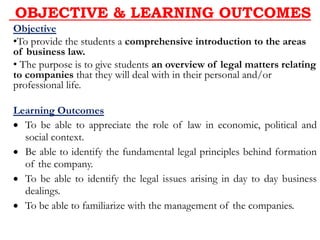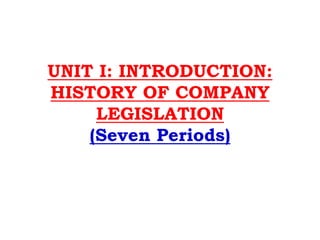The document provides a comprehensive overview of business law, focusing on company law, its evolution in India, and the various forms of business entities such as sole proprietorships, partnerships, and corporations. It outlines the objectives and learning outcomes for students, details the regulatory framework established by the Companies Act of 2013 and its amendments, and highlights key concepts such as one-person companies and corporate social responsibility. Additionally, it contrasts the characteristics and legal implications of different business structures, emphasizing the roles and responsibilities of shareholders and company directors.




































![TERMS & RESTRICTIONS OF OPC
• A person shall not be eligible to incorporate more than a
OPC or become nominee in more than one such company.
• Minor cannot become member or nominee of the OPC or
can hold share with beneficial interest.
• An OPC cannot be incorporated or converted into a Coy U/S
8 of the Act [Company not for Profit].
• An OPC cannot carry out Non-Banking Financial
Investment activities including investment in securities of
any body corporate.
• An OPC cannot convert voluntarily into any kind of
company unless two years have expired from the date of
incorporation of OPC, except threshold limit (paid up
share capital) is increased beyond Rs.50 Lakhs or its
average annual turnover during the relevant period exceeds
Rs.2 Crores i.e., then the OPC has to invariably file
forms with the ROC for conversion in to a Private or
Public Company, with in a period of Six Months on
breaching the above threshold limits.•
•](https://image.slidesharecdn.com/coylawunit1-170218153728/85/Coy-law-unit-1-37-320.jpg)




















